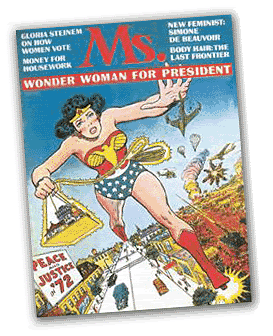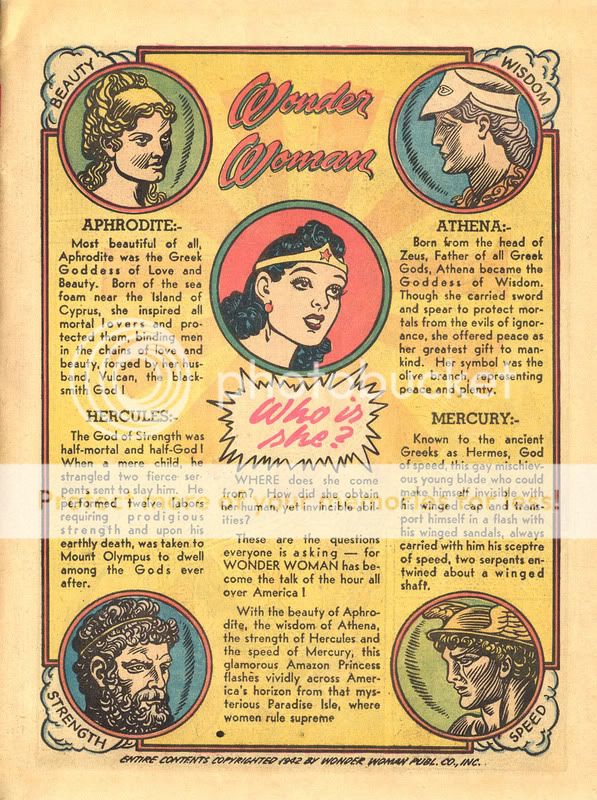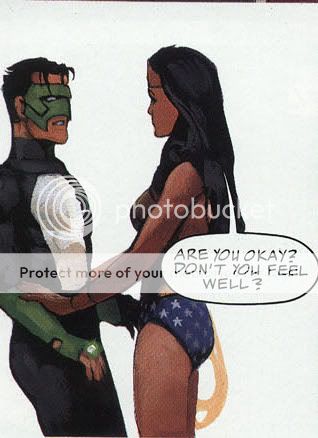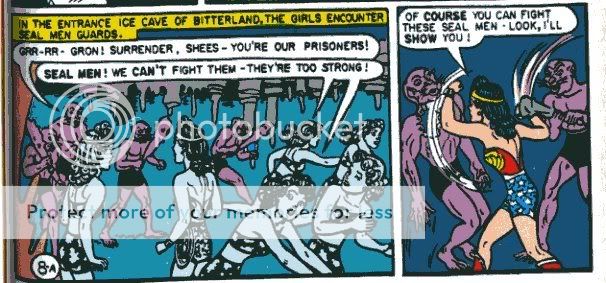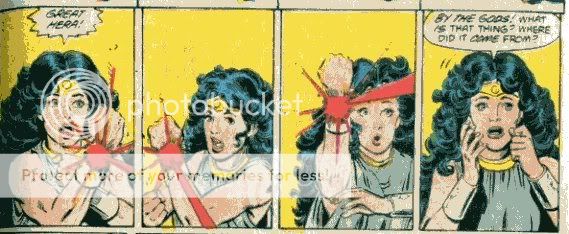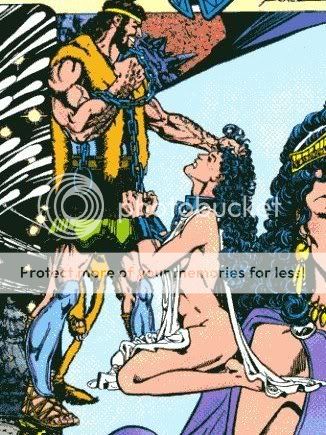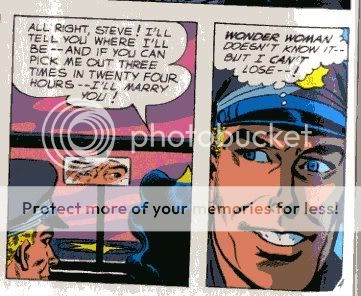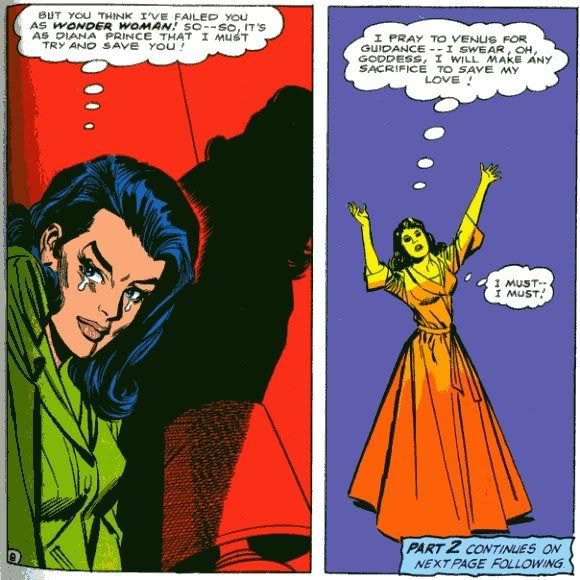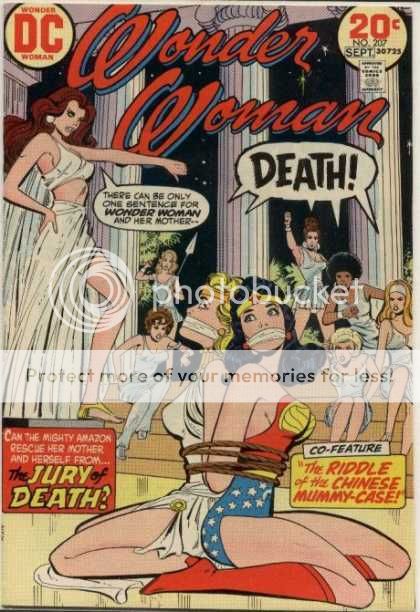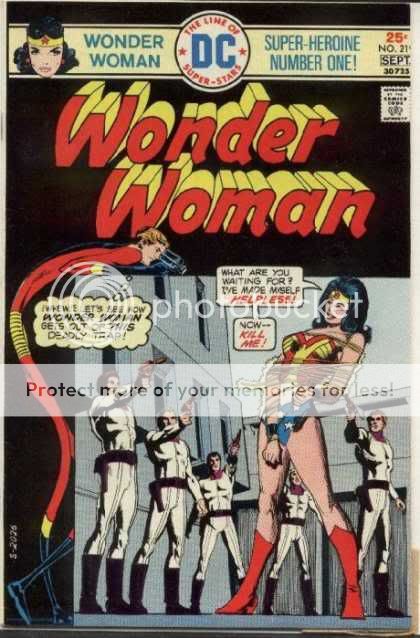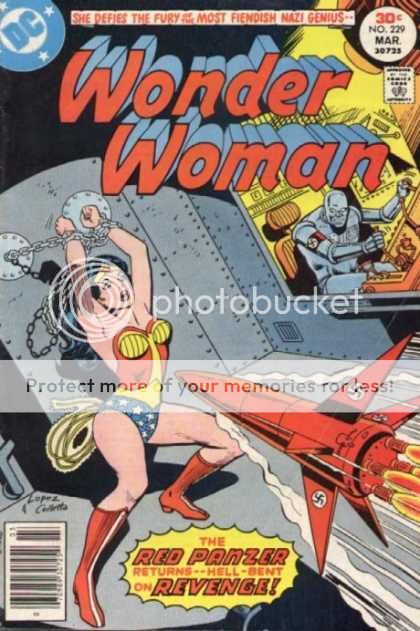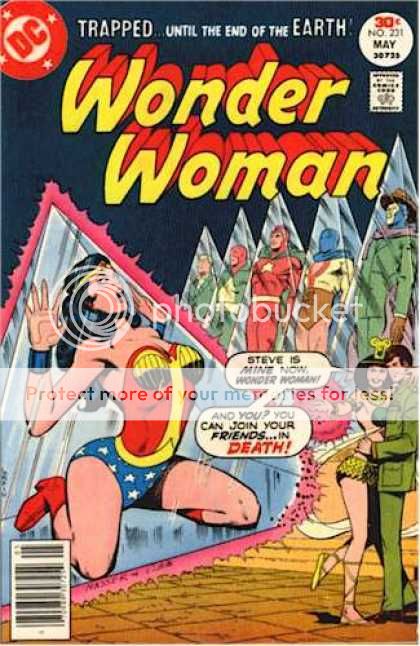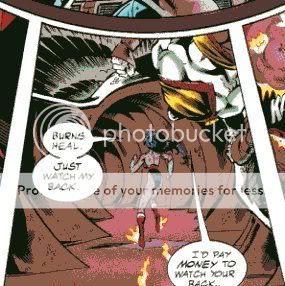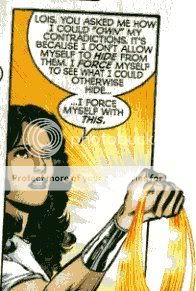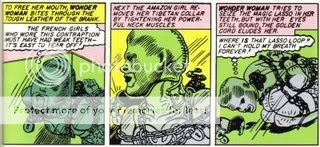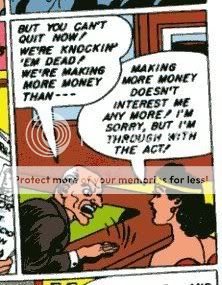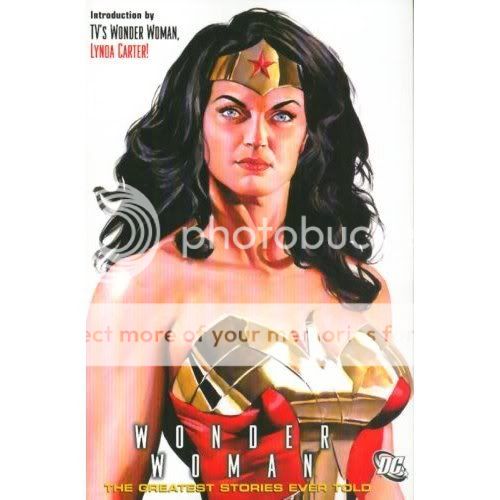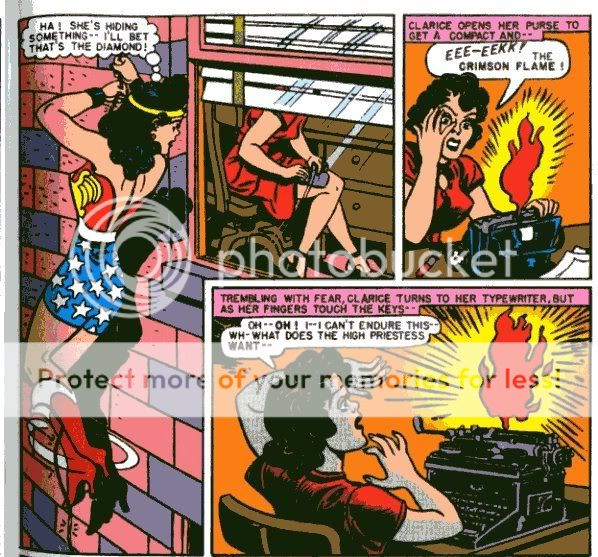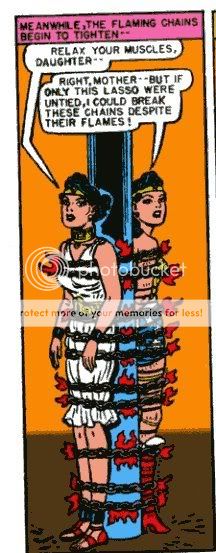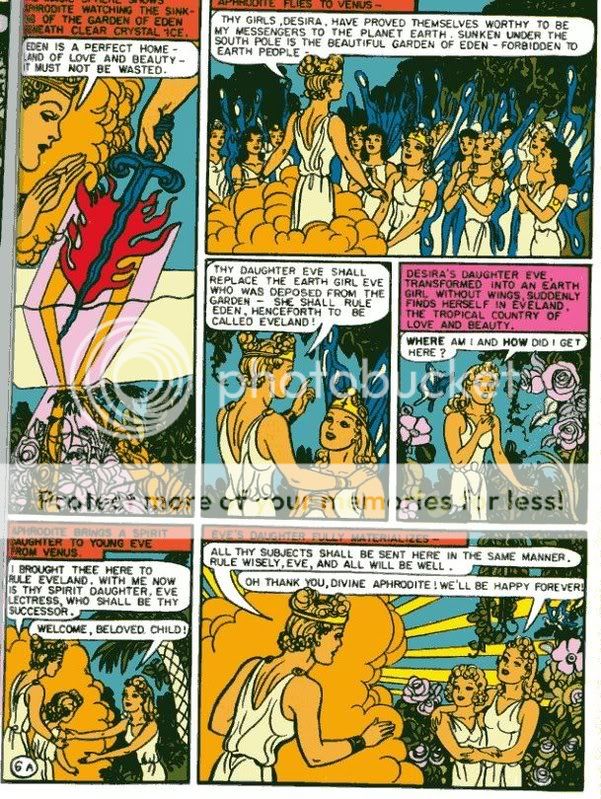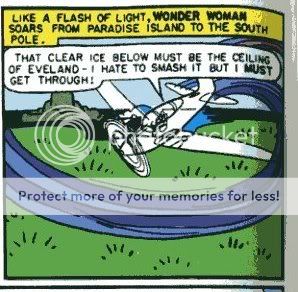Well, obviously, I’ve gotten completely obsessed with Wonder Woman. If you’re just checking in, you can find the rest of my posts on this subject here: One Two Three Four Five.
So far the basic thesis I’ve been arguing is that the original Moulton/Peter Wonder Woman was a very odd and original creation, and that nobody else has ever really figured out a way to use the character that isn’t ridiculous or offensive or boring or all three.
_________________
I’m going to take a slight turn here. I want to talk a little about Wonder Woman’s status as a feminist icon, and how that does or doesn’t really seem to make sense.
____________
I was aware that WW is generally thought of as a kind of feminist hero; an embodiment of strong, independent, heroic womanhood. I didn’t realize, though, that Gloria Steinem had actually put WW on the cover of the first issue of Ms. in 1972.
Steinem also wrote an essay about how strong and powerful Wonder Woman was, and about…well here’s a quote (taken from this very entertaining post on Comic Coverage:
“Looking back now at these Wonder Woman stories from the forties, I am amazed by the strength of their feminist message…Wonder Woman symbolizes many of the values of the women’s culture that feminists are now trying to introduce into the mainstream.” — Gloria Steinem
Anyway, because WW is supposed to symbolize feminism and female power, there was something of an outcry when this hit the stands, early in 2008
That’s Tiffany Fallon nude, with a Wonder Woman suit painted on her.
Greg Rucka, Wonder Woman writer, said “I’d rather have my daughter see this [the Ms. cover] than ever see that [the Playboy cover.]” And he added “Bastards all. You’ve no idea the damage you’ve done. No idea at all.”
I agree. The cover is a desecration. It goes against everything Charles Moulton believed; everything he stood for. How on earth could Playboy put Wonder Woman on the cover, and not have her tied up?
Slightly more seriously, I do have to wonder how, or what kind of, damage this sort of thing really does. In the first place…you really probably wouldn’t show Playboy to little kids anyway, would you? And in the second, how is this out of sync with Wonder Woman’s image (other than that it’s not bondage, I mean?) WW’s costume is pretty thoroughly sexualized to begin with. I guess you could argue that WW is about her strength and heroism, not her shallow physical charms — but that’s just not true. In fact, shallow physical charms are one of her super-powers. This is from the first issue of WW:
Note all the stuff about Aphrodite? WW’s beauty is, like her strength or her speed, a divine gift (from the God of Love, no less). This has been pretty consistent down through the years, too; she’s still got super-beauty in George Perez’s reboot, for example, and even the dragon notices she’s hot in League of One.
Valerie D’Orazio makes more or less the same point:
As for me, like I said, I wasn’t surprised by the Playboy thing. It was a cheap shot by the magazine, to be sure. But I would be far more outraged if this happened to Batgirl or Supergirl. To me, Batgirl was always the true feminist superheroine — smart, independent, and under-sexualized. Supergirl was the virginal innocent — originally portrayed as your own kid sister or cousin.
But, Wonder Woman was created by a dude with really strong and weird opinions about women & sex — he referred to women’s vaginas as their “love parts” — and all that baggage couldn’t help but taint that character. Adventurous, resourceful Batgirl is the superheroine I wanted to be. Wonder Woman was half-naked. ….Which is not to say that WW can’t be/has not been redeemed and made into a character that women and girls can truly look up to. But I will finally believe this when she’s no longer drawn by cheesecake artists. I’ll believe it when she’s no longer half-naked.
And yet…though I agree with the argument up to a point, I think D’Orazio’s missing something. After all, Ms. Magazine didn’t put Batgirl on the cover. And that’s in part because nobody except hardcore comics geeks like D’Orazio gives a rats ass about Batgirl. Wonder Woman has more name recognition; she’s got more appeal. In fact, there’s some evidence that Tiffany Fallon is painted to look like Wonder Woman not solely because some guy thought “Wonder Woman is hot” but because, you know, Tiffany Fallon really likes Wonder Woman. As she says:
I’m obsessed with Wonder Woman. I grew up and I had the Wonder Woman Underoos, when Underoos first came out. And I was always a big fan of the show and Lynda Carter. And the older I got, the more I would get these comments like, “My god, you look like Lynda Carter in that picture!” And it doesn’t happen all the time, but I just grew to appreciate her and the character and the campiness of the project. I was Wonder Woman at one of the Playboy Mansion parties, and I just started getting all these comments, like, “My god! You would make a great Wonder Woman!” And I’m like, “You know, I would!” [Laughs]. And so I just have fun with it. And I heard they were starting to make a movie about it, and so I was like, “You know… Stranger things have happened in my life!” You never know. But that would be something I’d be really proud to be a part of.
In other words, WW’s on the Playboy cover for the same reason she’s on the Ms. cover — because girls like her.
Just because women, or some women, or a woman likes something doesn’t necessarily make it feminist or liberating, of course. Pictures of super-thin models are quite popular with girls of all age; does that mean they’re necessarily liberatory? Or is the popularity arguably, from a feminist perspective, perhaps a problem?
(And, of course, the same goes for Fallon and the Playboy cover — she made have had input into the image, and the PR may have talked about how accomplished and wonderful she is, but that doesn’t mean that it’s especially empowering for women as a whole to have this image out there.
Though I’ve gotta say…there seemed to be a fair number of people who were shocked, shocked, shocked that Fallon would dare compare herself to Lynda Carter. I mean…Lynda Carter! I like Lynda Carter fine and all…but she’s a minor celebrity. Fallon’s a minor celebrity. It’s not like Fallon compared herself to Gloria Steinem or something.
Where was I? Oh yeah…)
Still, the question remains…granted that she’s a problematic feminist icon, why do girls like WW? Is it just because they’re all victims of false consciousness and propaganda and can’t tell that she’s an erotic tool of the patriarchal oppressor? Or what?
There are a bunch of reasons that girls might like Wonder Woman I think.
1. One of her powers is super-beauty. Girls are into being pretty. You can argue about whether this is cultural or biological (I lean towards the former) and about whether its unfortunate or not, but it is indisputably true
2. She’s got lots of strong female friendships and relationships. That’s not especially true for, say, Batgirl (except in more recent incarnations) but it’s always been true of Wonder Woman. (Trina Robbins talks about this here, in an essay I may discuss more at some point….)
3. She’s the star. Batgirl is Batman’s assistant; Supergirl is a secondary Superman; Storm’s part of a team, etc. etc., but Wonder Woman in those 40s adventures was the focus of the narrative. And that leads us to:
4. Moulton really did go out of his way to preach self-confidence and self-reliance to women. Say what you will about him, but he thought women were strong and that they should have confidence in themselves. He shows WW and other women beating the tar out of men, outwitting men, and generally overthrowing their oppressors (after being tied up, of course.)
5. She’s a princess.
6. She’s a princess. Duh.
All of the above can be summed up by saying that Moulton’s Wonder Woman really, truly, gratuitously, and effectively pandered to girls in a way very few other American super-hero comics have. Girls have traditionally liked Wonder Woman because it was marketed to them by someone who actually knew what he was doing.
Of course, Moulton was also pandering to his own fetishes. The genius of the character, if you want to call it that, is the way that she plugs into fetishes for men and women a the same time — whether it’s her beauty, or her relationships with other women, or her sub/dom/sub/dom flip-flopping. The story functions both as genre literature for girls and as “fanny” genre literature for guys. As a result, both the Ms. cover and the Playboy cover are logical places for the character to end up.
So where does that leave WW as a feminist icon? Well, about the same place it leaves her as stroke material, I guess. Because while it makes sense to use her in Ms. in some sense, Gloria Steinem still, still looks like kind of a doofus for putting her on the cover. And while Fallon certainly looks hot in those Playboy photographs, the magazine couldn’t resist puffing her as a champion of truth, justice and American Sensuality”, which is just dumb. And, it must be said again, it’s pretty lame to do a porn shoot based on a kid’s comic book and manage to be less kinky than the source material.
I guess we’re back at the thesis for this whole series of posts, which is that using Moulton’s character for your own purposes tends not to work very well (aesthetically I mean — commercially is something else, of course.) Putting WW on the cover made Playboy and Ms. look naive and clueless. You mess with the Amazon, you take your lumps.
Update: Fixed chronology error….
Update: the sage continues, with more on the Ms. cover, among other burblings…

